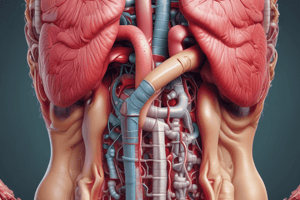Podcast
Questions and Answers
What are the two main functions of the digestive system?
What are the two main functions of the digestive system?
- Circulation
- Absorption (correct)
- Respiration
- Digestion (correct)
What is the digestive system composed of?
What is the digestive system composed of?
Mouth, Pharynx, Esophagus, Stomach, Small Intestine, Large Intestine
Accessory organs are located inside the digestive tract.
Accessory organs are located inside the digestive tract.
False (B)
How does the GI tract protect the body from infection?
How does the GI tract protect the body from infection?
What do enteric neurons enable?
What do enteric neurons enable?
What is the function of salivary glands?
What is the function of salivary glands?
What does the pancreas do?
What does the pancreas do?
What is the role of the liver in digestion?
What is the role of the liver in digestion?
What is the main function of the small intestine?
What is the main function of the small intestine?
What are plicae?
What are plicae?
What is the function of the ileum?
What is the function of the ileum?
What characterizes the large intestine?
What characterizes the large intestine?
What is an acute inflammation of the serous membrane lining the abdominal cavity called?
What is an acute inflammation of the serous membrane lining the abdominal cavity called?
The ____________ is a sphincter (valve) between the ileum and large intestine.
The ____________ is a sphincter (valve) between the ileum and large intestine.
The portion of the small intestine that is attached to the stomach is the _________________
The portion of the small intestine that is attached to the stomach is the _________________
The enzyme that is present in saliva is called ______________
The enzyme that is present in saliva is called ______________
The cells in gastric glands that secrete pepsinogen are called _______________
The cells in gastric glands that secrete pepsinogen are called _______________
What regulates the smooth muscle activity in the GI tract?
What regulates the smooth muscle activity in the GI tract?
Flashcards
Digestive System Function
Digestive System Function
The primary functions of the digestive system are digestion and absorption.
Major Digestive Organs
Major Digestive Organs
The main components of the digestive system are the mouth, pharynx, esophagus, stomach, small intestine, and large intestine.
Accessory Digestive Organs
Accessory Digestive Organs
Organs outside the digestive tract aiding digestion include teeth, tongue, salivary glands, liver, gallbladder, and pancreas.
GI Tract Protection
GI Tract Protection
Signup and view all the flashcards
Enteric Nervous System
Enteric Nervous System
Signup and view all the flashcards
Interstitial Cells of Cajal
Interstitial Cells of Cajal
Signup and view all the flashcards
Salivary Glands
Salivary Glands
Signup and view all the flashcards
Pancreas Function
Pancreas Function
Signup and view all the flashcards
Bile Duct and Liver
Bile Duct and Liver
Signup and view all the flashcards
Large Intestine Function
Large Intestine Function
Signup and view all the flashcards
Small Intestine Structure
Small Intestine Structure
Signup and view all the flashcards
Small Intestine Absorption
Small Intestine Absorption
Signup and view all the flashcards
Digestive Disorders
Digestive Disorders
Signup and view all the flashcards
Enteric Nervous System Independence
Enteric Nervous System Independence
Signup and view all the flashcards
Autonomic Nervous System Influence
Autonomic Nervous System Influence
Signup and view all the flashcards
Key Digestive Sphincters
Key Digestive Sphincters
Signup and view all the flashcards
Gastric Structures and Secretions
Gastric Structures and Secretions
Signup and view all the flashcards
Nutrient Absorption Location
Nutrient Absorption Location
Signup and view all the flashcards
Rectum/Anus Function
Rectum/Anus Function
Signup and view all the flashcards
Specialized GI Cells
Specialized GI Cells
Signup and view all the flashcards
Mesentery Function
Mesentery Function
Signup and view all the flashcards
Peritonitis
Peritonitis
Signup and view all the flashcards
Dysphagia
Dysphagia
Signup and view all the flashcards
Nausea
Nausea
Signup and view all the flashcards
Anorexia
Anorexia
Signup and view all the flashcards
Study Notes
Functions of the Digestive System
- Digestion and absorption are the two primary functions of the digestive system.
Composition of the Digestive System
- Main components include mouth, pharynx, esophagus, stomach, small intestine, and large intestine.
Accessory Organs
- Accessory organs outside the digestive tract include teeth, tongue, salivary glands, liver, gallbladder, and pancreas.
GI Tract and Protection
- The GI tract protects the body from infection by absorbing essential nutrients, electrolytes, vitamins, and excreting waste.
Enteric Neurons
- Known as the "little brain," enteric neurons enable reflex actions, such as peristalsis, to facilitate movement of contents.
Interstitial Cells of Cajal
- These cells act as pacemakers, regulating the frequency and strength of muscle contractions in the GI tract.
Role of Salivary Glands
- Salivary glands produce saliva, which moistens the mouth, aids in carbohydrate breakdown, and lubricates food for swallowing.
Pancreas Functions
- The pancreas serves both endocrine (releasing hormones into the bloodstream) and exocrine (secreting digestive juices) functions to aid food digestion.
Bile Duct and Liver
- Bile duct carries bile from the gallbladder to the duodenum, while the liver processes nutrients and secretes bile crucial for fat digestion.
Structure of the Large Intestine
- Major function is absorbing water and transmitting waste. Taenia coli contracts to form haustra, which give the colon its segmented appearance.
Small Intestine Anatomy
- Divided into three segments: duodenum, jejunum, and ileum, where 90% of digestion and absorption takes place.
Special Features of the Small Intestine
- Circular folds (plicae) and finger-like projections (villi and microvilli) increase surface area for optimal nutrient absorption.
Disorders of the Digestive System
- Conditions like dyspepsia (indigestion), irritable bowel syndrome, and peptic ulcers affect digestive health and functionality.
Enteric Nervous System
- Functions independently of the central nervous system and is influenced by both parasympathetic and sympathetic branches.
Autonomic Nervous System Influence
- Parasympathetic stimulation increases GI motility and secretions, while sympathetic stimulation inhibits these actions.
Key Sphincters in the Digestive System
- The lower esophageal sphincter controls entry into the stomach, while the ileocecal valve regulates flow into the large intestine.
Gastric Structures and Secretions
- Unique cells in the stomach include parietal (HCl secretion), chief (pepsinogen), and G cells (gastrin production) for digestion.
Absorption of Nutrients
- Jejunum absorbs small nutrient particles; ileum focuses on vitamin B12 and bile salt absorption, enhancing overall nutrient intake.
Rectum and Anus Functions
- The rectum serves as a temporary storage site for feces, with internal and external anal sphincters regulating waste elimination.
Specialized Cells in the GI Tract
- Chief cells (secreting pepsinogen) and mucus-secreting cells are crucial for maintaining the digestive environment in the stomach.
Mesentery
- Structure attaching the large intestine to the posterior abdominal wall, providing support and vascular supply.
Acute Inflammation
- Peritonitis refers to the acute inflammation of the serous membrane lining the abdominal cavity and covering viscera.
Key Terms for Understanding
- Define dysphagia (difficulty swallowing), nausea (sickness with vomiting inclination), and anorexia (eating disorder focused on weight).
Studying That Suits You
Use AI to generate personalized quizzes and flashcards to suit your learning preferences.





